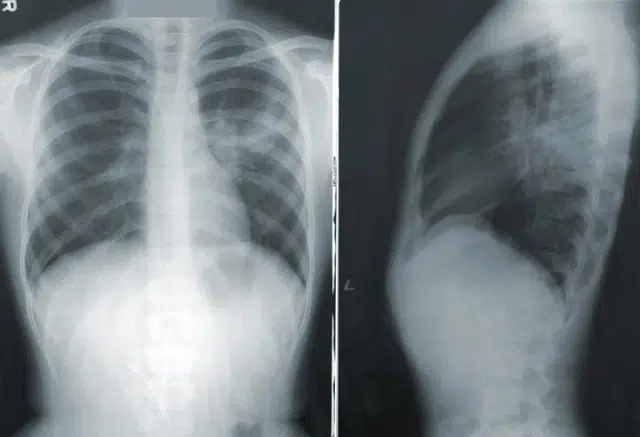Radiological imaging is very useful in visualising the chest and lungs to establish a diagnosis.
Commonly used radiological imaging includes:

Chest x-rays can be obtained quickly and offer a rapid general view of the lungs to make an initial diagnosis or determine progress after treatment.
The radiation from a chest x-ray is 0.02 mSV and is equivalent to 5 days of background radiation.
CT scans offer a more detailed view of the chest including the heart, blood vessels, lymph nodes, airways, lung tissue and chest wall. Usually the test takes only a few seconds. Sometimes a dye (contrast) is injected to better help visualise specific structures and scans taken before and after injection of dye. For example, injection of dye and scanning whilst the dye is in the pulmonary arteries allows the detection of clots (emboli) within the pulmonary arteries. On other occasions scans need to be taken during inspiration and expiration to help in identifying specific airways disease.
Regarding the contrast, it is important that you let Dr Jose know if you are allergic to iodine.
A CT scan delivers approximately 6.1 mSV of radiation that is equivalent to 2 years of background radiation. However, in some cases, for example with lung cancer screening, low dose CT scans can be done, which reduce the radiation dose to 1.5 mSV.
PET CT scans are nuclear medicine scans where a nuclear dye is injected to demonstrate areas of the body that are more active. They imaging is combined with CT scans to offer 3D visualisation of the body and is particularly useful to detect active sights of inflammation, infection and cancer.
The scan is safe but pregnant woman should only have it in an emergency. The scan delivers approximately 22 mSV of radiation that is equivalent to 3 years of background radiation. Drinking plenty of water after the scan helps to flush the body of the radioactive tracer. As a precaution you should avoid coming in to close contact with pregnant woman and young children for 6 hours.
These scans use radioactive tracer to detect ventilation (airflow) and perfusion (blood flow) in the lungs. This allows detection of areas where there is a problem with ventilation or perfusion and helps make a diagnosis of pulmonary emboli (blood clots in the lungs). As the test is done in two parts it can take up to 30 min to complete.
Ventilation-Perfusion scans can be combined with CT using single-photon emission computed tomography (SPECT) to provide 3D information, with lower dose of radiation that with a CT pulmonary angiogram, and avoiding the use the contrast
This is often the investigation of choice to detect blood clots in the lungs of pregnant woman, using only the radioactive tracer to detect perfusion, as CT pulmonary angiogram delivers a higher dose of radiation to the breast tissue of pregnant woman.
MRI scans use magnetic fields and radio-frequency pulses to create detailed images of the body. They are particularly useful in the imaging of the chest wall, mediastinum, pleura, heart and blood vessels. The imaging of lung parenchyma is less detailed and CT is preferred to detect lung tissue abnormalities. Importantly, for good quality images the person has to remain still and breath-hold during the recording of the images.
Lying in a tunnel MRI machine for you scan may make people feel claustrophobic (fear of enclosed spaces). If fear enclosed spaces you may need to have a sedative before your MRI or, in more severe cases where a sedative will be unhelpful, have your scan in an open MRI.
Sometimes contrast called gadolinium is administered. This contrast can be used in individuals with allergy to iodine but is usually contra-indicated in severe renal disease.
Although safe in pregnancy it is advised that MRI scans should be avoided in the first trimester unless the benefits outweigh potential risks.
Remember that metal and electronic items are not allowed in the MRI room and need to be removed. MRI scans are contraindicated in people with some types of metal clips used in blood vessels, some types of cochlear implants, older pacemakers and vagal nerve stimulators.t
Respiratory Medicine
Royal Brompton Hospital
Sydney Street
Chelsea
SW3 6NP